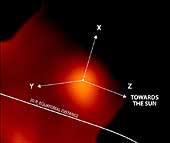|
COMETS EARTH JUPITER KUIPER BELT MARS MERCURY METEORITES NEPTUNE OORT CLOUD PLUTO SATURN SOLAR SYSTEM SPACE SUN URANUS VENUS ORDER PRINTS
PHOTO CATEGORIES SCIENCEVIEWS AMERICAN INDIAN AMPHIBIANS BIRDS BUGS FINE ART FOSSILS THE ISLANDS HISTORICAL PHOTOS MAMMALS OTHER PARKS PLANTS RELIGIOUS REPTILES SCIENCEVIEWS PRINTS
|
Related Documents
Download Options
Images from the magnetospheric imaging instrument and the ion and neutral camera onboard the Cassini spacecraft reveal aspects of the interactions between Saturn's dynamic population of hot energetic ions and the clouds of cold neutral atoms. Future observations may further explain the relationships between these interactions. The most recent image of Titan reveals the emission of high-speed neutral atoms from a globular region approximately 70,000 kilometers (43,496 miles) in diameter, clearly centered on Titan. It is only 1/25 as bright as the region seen toward dawn during Saturn orbit insertion, even though Cassini is now closer to Titan. There is an extended emission region around the Titan cloud, but it is much dimmer than the Titan cloud itself and even dimmer compared to the emission seen in the dawn direction at orbit insertion. In this image, the X marks the direction toward the Sun; the Y marks the direction toward Saturn's dawn; and the Z marks Saturn's rotation axis. The dot in the center marks Titan. |
